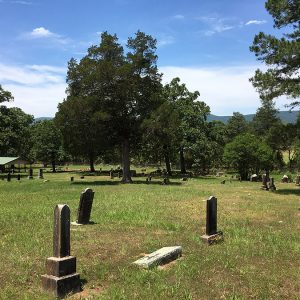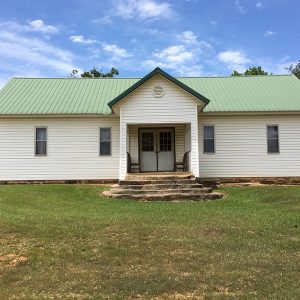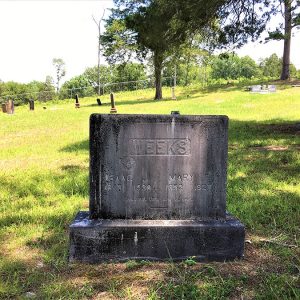calsfoundation@cals.org
Weeks (Scott County)
Weeks is an unincorporated community located in northwestern Scott County south of Highway 28. Weeks was established circa 1882 just south of the Poteau River. Agriculture has traditionally been important to the area.
Prior to European exploration, Weeks was a wilderness lush with native vegetation and numerous species of wildlife. Archaeological evidence from the Archaic, Woodland, and Mississippian periods has been discovered throughout the area. Additional archaeological evidence has indicated that the Caddo tribe had a strong presence along the Poteau River and other prominent waterways.
Throughout the early seventeenth and late eighteenth centuries, French trappers and explorers traveled west from Arkansas Post along the Arkansas River. From there, they began traversing smaller tributaries such as the Fourche La Fave River and Poteau River. It is likely that they traveled through the area where Weeks is now located.
Settlers began arriving in the area near Weeks as early as the late 1820s. The area continued to be settled from the 1830s to the 1880s. Most families participated in a wide variety of agricultural practices.
Men in the Weeks area who were called to fight in the Civil War served with both the Confederacy and Union. The women and elderly were left to look after the homes and farms.
After the Civil War, there was a large migration movement into western Scott County, with many settlers making homes in the Weeks community. In the 1870 census, there were seventy-six families living in Lafayette Township, and by 1880 there were 175. Three of the larger families to move to the area after the war were the McDaniel, Autrey, and Taylor families.
After Reconstruction, Weeks grew into a more established community. Weeks Cemetery was established circa 1879 on land given by William T. Autrey and later named for the Weeks family who settled in the area in 1880s. A second smaller cemetery called Black Cemetery is located north of Weeks; however, it is inaccessible by road and located on private property.
In the early to mid-1880s, Isaac J. Weeks traveled from Muhlenberg County, Kentucky, to Scott County near present-day Weeks. Isaac traveled with his wife, Mary, and five children: Martha, Elisha, James, Samuel, and a two-month-old whose name is unknown. Isaac and his wife had two more children, Marnie and Marcus, after moving to Scott County. Isaac was a farmer and merchant in the area. He often traveled to Waldron (Scott County) to do business. The town of Weeks was subsequently named after the Weeks family.
In May 1882, the Scott County Courthouse burned, destroying all records that defined the boundaries of the various school districts that had been established throughout the county. Several months later in August, the county court reestablished the boundaries of the fifty-six school districts active in the county, including Weeks School District (No. 29). The first school house at Weeks was located near the Weeks Cemetery. In April 1886, citizens of the western half of Weeks School District petitioned the court for a new school. The petition was granted, and the Sylvan Bowers School District (No. 68) was formed from half of the Weeks School District. The Sylvan Bowers School House was named Glasses’ School House after John M. Glass, who led the petition for the new school. In 1894, the Sylvan Bowers School District was re-consolidated with Weeks School District.
The Weeks Post Office was established in June 1902, with James Weeks as the first postmaster. In 1922, the post office was discontinued, with the mail being sent to Heavener, Oklahoma. During the Great Depression, many farmers in the area faced economic distress as the price of cotton and crops dropped significantly.
Several members of the Weeks community were drafted into service during World War II. Soon after the war, Weeks declined significantly with the loss of the school. Weeks School District was consolidated with Waldron sometime between 1949 and 1953.
There is little to no commercial infrastructure remaining in Weeks in the twenty-first century; however, it is still an active community. The Cedar Creek Baptist Church and Weeks Community Center are well kept and used regularly. It is unclear as to when the church and community center were built, but it is likely that they were constructed in the late nineteenth or early twentieth centuries. Agriculture continues to be an important practice in the area, mainly in the form of cattle and chicken farms. Hunting and fishing are popular activities among residents.
For additional information:
Cate, Michael. History of Scott County, Arkansas. Dallas, TX: Curtis Media Corporation, 1991.
Echoes: The Scott County Historical and Genealogical Society Quarterly. Waldron, AR: Scott County Historical and Genealogical Society (1986–).
Goodner, Charles. Scott County in Retrospect. Mansfield, AR: Frank Boyd, 1976.
Goodner, Norman. A History of Scott County, Arkansas. Siloam Springs, AR: Bar D Press, 1941.
McCutcheon, Henry Grady. History of Scott County, Arkansas. Little Rock: H. G. Pugh and Company, 1922.
Ty Richardson
Richardson Preservation Consulting
 Cedar Creek Baptist Church
Cedar Creek Baptist Church  Scott County Map
Scott County Map  Weeks Cemetery
Weeks Cemetery  Weeks Community Center
Weeks Community Center  Weeks Headstone
Weeks Headstone 



Comments
No comments on this entry yet.